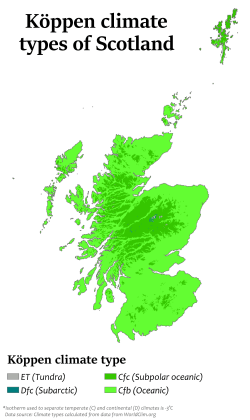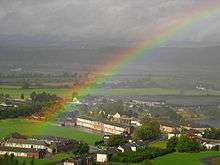Climate of Scotland


The climate of Scotland is temperate and oceanic (Köppen climate classification Cfb), and tends to be very changeable, but not normally extreme. It is warmed by the Gulf Stream from the Atlantic, and given its northerly latitude it is warmer than areas on similar latitudes, for example Labrador in Canada—where the sea freezes over in winter and icebergs are a common feature in spring and early summer, or Fort McMurray, Canada—where −35 °C (−31 °F) is not uncommon during winter. Even though most of the country has a temperate climate, the Northern islands and Highlands experience a type of weather close to the climate of the Faroe Islands or Southern Norway.
Temperature
Scotland occupies the cooler northern section of Great Britain, so temperatures are generally lower than in the rest of the British Isles, with the coldest ever UK temperature of −27.2 °C (−17.0 °F) recorded at Braemar in the Grampian Mountains, on 10 January 1982 and also at Altnaharra, Highland, on 30 December 1995.[1] Winters in Scotland have an average low of around 0 °C (32 °F),[2] with summer maximum temperatures averaging 15–17 °C (59–63 °F).[3] In general, the western coastal areas of Scotland are warmer than the east and inland areas, due to the influence of the Atlantic currents, and the colder surface temperatures of the North Sea.[4] The highest temperature recorded was 32.9 °C (91.2 °F) at Greycrook, Scottish Borders on 9 August 2003.[1] For the last 100 years, the coldest winter was in 1963 (average temperature 0.19 °C or 32.34 °F) and the mildest was in 1989 (average 5.15 °C or 41.27 °F). The warmest summer was in 2003 (average 14.07 °C or 57.33 °F) and the coolest was in 1922 (average 10.64 °C or 51.15 °F).[5] Since 1991, only five winters and four summers have been below average warmth (referring to the period 1971 – 2000).
Rainfall

Rainfall totals vary widely across Scotland— the western highlands of Scotland is one of the wettest places in Europe with annual rainfall up to 4,577 mm (180.2 in).[6] Due to the mountainous topography of the western Highlands, this type of precipitation is orographic in nature, with the warm, wet air forced to rise on contact with the mountainous coast, where it consequently cools and condenses, forming clouds. In comparison, much of eastern Scotland receives less than 870 mm (34.3 in) annually; lying in the rain shadow of the western uplands.[6] This effect is most pronounced along the coasts of Lothian, Fife, Angus and eastern Aberdeenshire, as well as around the city of Inverness. Inchkeith in the Firth of Forth receives only 550 mm (21.7 in) of precipitation each year, which is similar to Rabat in Morocco, and less than Barcelona receives per year. Also, as a result of this the north-western coast has about 265 days with rain a year and this falls to the south east to a minimum of about 170 days along the coast to the east of high ground. Snowfall is normally common in the lowlands, but becomes more common with altitude. Parts of the Highlands have an average of 46 to 105 snow days per year,[7] while some western coastal areas have between 42 and 87 with snow a year.[7]
Sunshine
The maximum amount of sunshine in a calendar month was 329 hours in Tiree in May 1946 and again in May 1975 while the minimum, a mere 36 minutes, was recorded at Cape Wrath in the Highlands in January 1983.[8] Dundee is the sunniest city in Scotland. On the longest day of the year there is no complete darkness over the northern isles of Scotland. Lerwick, Shetland, has about four hours more daylight at midsummer than London, although this is reversed in midwinter. Annual average sunshine totals vary from as little as 711–1140 hours in the highlands and the north-west,[9] up to 1471–1540 hours on the extreme eastern and south-western coasts.[9] Average annual sunshine hours over the whole territory are 1160 (taking 1971 to 2000 as standard) meaning that the sun shines just over 25% of the time.
Winds
Scotland is the windiest country in Europe due to eastward moving Atlantic depressions that bring strong winds and clouds continuously throughout the year.[10][11] In common with the rest of the United Kingdom, wind prevails from the south-west.[1] The windiest areas of Scotland are in the north and west; parts of the Western Isles, Orkney and Shetland have over 30 days with gale force winds per year.[1] Vigorous Atlantic depressions, also known as European windstorms, are a common feature in the autumn and winter in Scotland. The strongest wind gust recorded in Scotland was officially 278 kilometres per hour (173 mph) on 20 March 1986 in Cairngorms, but an unofficial wind speed of 312 kilometres per hour (194 mph) was recorded in the same location on 19 December 2008.[12]
References
- 1 2 3 4 "Met Office: Scottish climate". Met Office. 2001. Archived from the original on 27 May 2007. Retrieved 20 August 2007.
- ↑ "Scottish winter temperature". Current Results. Retrieved 16 January 2015.
- ↑ "Scotland 1971–2000 averages". Met Office. 2001. Archived from the original on 30 April 2004. Retrieved 20 August 2007.
- ↑ "Mean Temperatures Annual Average". Met Office. 2001. Archived from the original on 1 August 2013. Retrieved 20 August 2007.
- ↑ http://www.metoffice.gov.uk/climate/uk/summaries/2003/summer/regional-values
- 1 2 "Rainfall Amount Annual Average". Met Office. 2001. Archived from the original on 19 July 2013. Retrieved 20 August 2007.
- 1 2 "Days of Snow Lying Annual Average". Met Office. 2001. Archived from the original on 9 August 2007. Retrieved 20 August 2007.
- ↑ "Scotland Sunshine Statistics". Met Office. 2008. Retrieved 7 July 2008.
- 1 2 "Sunshine Duration Annual Average". Met Office. 2001. Archived from the original on 28 July 2014. Retrieved 20 August 2007.
- ↑ "Niall Stuart: Europe's windiest country is blessed with limitless energy potential". The Scotsman. 5 June 2012. Retrieved 16 January 2015.
- ↑ "The windiest place in Europe". BBC. 12 October 2011. Retrieved 16 January 2015.
- ↑ Britten, Nick (6 January 2009). "Highlands mountain claims strongest UK wind". The Daily Telegraph. Retrieved 16 January 2015.
